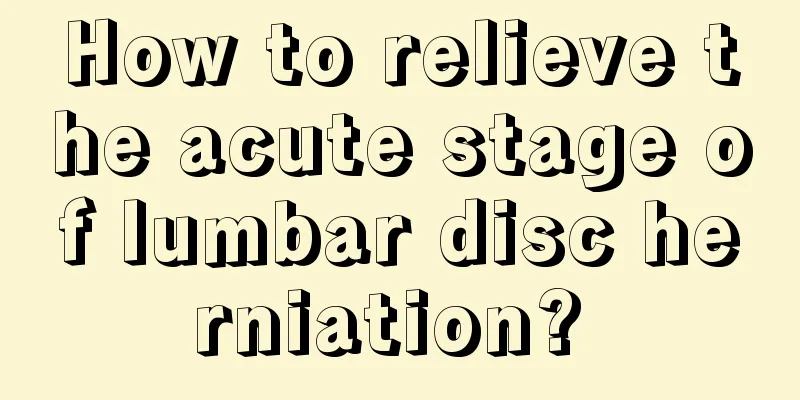How to treat lumbar protrusion and numbness in feet

|
Lumbar disc herniation is the abbreviation of lumbar disc herniation, which is a relatively common bone disease and is very harmful. There will be many symptoms after suffering from lumbar disc herniation. Many patients will experience numbness in the feet. Frequent occurrence has a great impact on normal life. Therefore, certain measures must be taken to solve this problem. So, how to treat lumbar disc herniation and numbness in feet? Let’s take a closer look below. Lumbar spine CT or MRI is recommended Patients with numbness in the lumbar spine are advised to go to a local tertiary hospital to take a lumbar spine radiograph. If further diagnosis is needed, a lumbar spine CT or lumbar spine MRI can be performed to confirm the location and extent of the lesion and avoid blind treatment. Then, an orthopedic surgeon can be consulted to make an assessment and future treatment plan. Lumbar disc herniation and leg numbness can be treated with drugs If an acute attack of leg numbness caused by lumbar disc herniation affects sleep, you can take some non-steroidal anti-inflammatory drugs orally under the guidance of a doctor, or apply non-steroidal anti-inflammatory suppositories externally into the anus, both of which have a good effect in relieving pain and relieving leg numbness. You can also take some Chinese patent medicines orally that have the effects of promoting blood circulation, removing blood stasis, strengthening the spleen and removing dampness, which can relieve the numbness between the waist and legs to a certain extent. You can also take some nerve nourishing drugs and B vitamins orally, which can serve as an auxiliary treatment. Pay attention to your sleeping position and mattress Choose a slightly harder mattress, but don't lie directly on a hard board as it is not conducive to blood circulation. Sleeping posture is also very important. When you choose to sleep on your side, put a pillow between your legs to help reposition the lumbar disc. When you choose to lie flat on your back, use as low a pillow as possible and put a pillow under the popliteal fossa of your leg to help relax the spine and help relieve leg numbness. Resting in a supine position or changing positions frequently It is recommended to lie down and rest when the lumbar disc is acutely attacked. If it is relieved or you are busy at work, you can change your posture frequently. It is best not to sit for a long time. Driving and typing on the computer are the postures that are most harmful to the waist. It is best to get up and move around every 20-30 minutes. In addition, you should avoid bending over to lift heavy objects; do not do heavy physical work or strenuous exercise. You can choose conservative treatment with traditional Chinese medicine There are many methods of conservative treatment in traditional Chinese medicine, but they vary from person to person. Acupuncture and cupping are suitable for people with wind-cold in the body {preferably fire cupping); people with inflammation and edema of the lumbar spine are suitable for local paste medicine, and it is best to apply the paste medicine on the Huantiao acupoint to better relieve leg numbness; if the lumbar disc nucleus pulposus herniation is serious, traction is needed to help reduce the position; people with lumbar disc numbness and leg numbness can also get good results from Chinese medicine massage; if people have dislocation of the lumbar facet joints, they need to be reduced and fixed by a Chinese medicine orthopedic doctor. Physical therapy combined with some exercises Physical therapy can be performed in the hospital or at home, for 20-30 minutes each time, 1-2 times a day. It is recommended to lift both lower limbs alternately and simultaneously in bed for 20-30 minutes every day; you can also do the small swallow flying exercise and the five-point exercise in bed; you can also hang on the horizontal bar in the community. Doing these movements can increase the strength of the lumbar muscles, relieve symptoms and control attacks. Surgery for patients with progressively worsening or persistent symptoms If the symptoms of lumbar cross-leg numbness do not improve or recur after 3-6 months of conservative treatment, you need to go to the hospital for further diagnosis and treatment in time, listen to the advice of orthopedic specialists, and decide whether to continue conservative treatment or require surgical treatment. It is best to visit two or more hospitals before deciding whether to undergo surgery. |
<<: Why does eating watermelon on an empty stomach cause stomach pain?
>>: What to do if your hands and feet become numb due to high blood pressure
Recommend
What causes premature graying of hair?
Some of our friends have gray hair when they are ...
Principles of long-term medication for osteosarcoma
Osteosarcoma can cause discomfort in patients'...
How to remove moisture by soaking your feet
Soaking your feet is a very enjoyable thing. It n...
What are the characteristics of cervical cancer? What are the treatments for cervical cancer?
In recent years, the incidence of cervical cancer...
Which hospital is good for treating bile duct cancer
Due to various reasons, in modern society, cancer...
What should I do if I have less hair on the top of my head
Everyone should have heard of Guangmingding, whic...
How to eat properly in late stage of pituitary tumor
It is said that "food is the first necessity...
How many days should I take the anti-inflammatory drip after the armpit odor surgery
If we have body odor, it will be very embarrassin...
What is Indian magic oil
Speaking of Indian magic oil, everyone must have ...
Pain at the junction of thigh and pelvis
Various reasons can cause pain symptoms at the co...
What should you eat for gallbladder cancer
Gallbladder cancer has no specific and typical sy...
Detailed introduction to common prevention methods for gastric cancer
Gastric cancer is a common disease. Its incidence...
The effect of foot bath with safflower, mugwort and ginger
Soaking feet in safflower and mugwort leaves is a...
My cervical vertebra hurts after a good sleep
After a day of non-stop running and busyness, lyi...
How to treat erosive athlete's foot more effectively
Erosive athlete's foot can be treated with so...









